Responses to controlled release potassium fertilisers in agriculture following phosphate mining
Katinka X. Ruthrof A B C H , Emma Steel A B , Ron Yates A B , Peter Skinner D , Neil Ballard E , Luca De Prato A B , Hervé Calmy F , Sunil Misra G , Jen McComb A , Graham O’Hara A B , Giles E. St J. Hardy A and John Howieson A B
A B C H , Emma Steel A B , Ron Yates A B , Peter Skinner D , Neil Ballard E , Luca De Prato A B , Hervé Calmy F , Sunil Misra G , Jen McComb A , Graham O’Hara A B , Giles E. St J. Hardy A and John Howieson A B
A Environmental and Conservation Sciences, Murdoch University, 90 South Street, Murdoch, WA 6150, Australia.
B Centre for Rhizobium Studies, Murdoch University, 90 South Street, Murdoch, WA 6150, Australia.
C Biodiversity and Conservation Science, Department of Biodiversity, Conservation and Attractions, Kensington, WA 6151, Australia.
D El-Wassat, Rockingham, WA 6168, Australia.
E Global Pasture Consultants, Narrogin, WA 6312, Australia.
F Calmy Planning and Design Pty Ltd, Waterford, WA 6152, Australia.
G Troforte Innovations, 36 Paramount Drive, Wangara, WA 6065, Australia.
H Corresponding author. Email: k.ruthrof@murdoch.edu.au
Soil Research 59(7) 727-736 https://doi.org/10.1071/SR20309
Submitted: 1 November 2020 Accepted: 12 April 2021 Published: 16 July 2021
Journal compilation © CSIRO 2021 Open Access CC BY-NC-ND
Abstract
The transition from mining to agriculture is hampered by a range of abiotic challenges to crop growth, including nutritional issues and heavy metal stress. Building on our previous work showing that potassium (K) limits legume growth in post-phosphate mining substrates on tropical Christmas Island, Australia, we undertook two field trials. The first compared the efficacy of controlled release K fertilisers (CRFs: KCl 2-month release, K2SO4 3-month and K2SO4 9-month) with immediately available potassium sulfate (K2SO4) fertiliser, on the legume Lablab purpureus. The second trial tested responses of L. purpureus to different rates of K2SO4 9-month CRF, and a combination treatment (CRF and K2SO4). Both trials were undertaken to determine how CRFs compare with immediately available K2SO4 in terms of increasing biomass, reducing cadmium (Cd) concentrations, maximising plant K concentrations and maintaining K soil retention. The first trial revealed that K2SO4 3-month and 9-month CRFs were similar to the 160 kg/ha K2SO4 treatment in significantly increasing L. purpureus biomass. Plant Cd and other heavy metal concentrations were significantly lower as plant biomass increased with increasing K, including with CRFs. The second trial showed no difference between various rates of K2SO4 9-month CRF and immediately available 160 kg/ha K2SO4 to increase biomass, reduce Cd or increase K concentrations. We have shown that although post-phosphate mining substrates can limit legume growth, high biomass can be attained with some CRFs, or K2SO4 at 160 kg/ha. Optimising nutrient input in post-mining agriculture is critical for developing safe, sustainable crops.
Keywords: nutrition, heavy metal, food production, remote community, food security.
Introduction
Conversion of old mine sites to agriculture, although important and attractive for many social, economic and environmental reasons, presents significant biotic and abiotic challenges to crop establishment and growth (Rowland et al. 2009; Godfray et al. 2010; McHenry and Persley 2015). Abiotic challenges include substrates with limited nutritional value and, occasionally, elevated concentrations of heavy metals (Singh and Singh 2001; Tischew and Kirmer 2007; Ruthrof et al. 2018a). In the post-phosphate mining agricultural activities on Christmas Island, Indian Ocean, Australia, for example, while the post-mining substrate is high in phosphorus (P), legume and cereal growth are limited by low levels of potassium (K) and nitrogen (N), respectively (Howieson et al. 2017; Ruthrof et al. 2018a, 2018b). Another major abiotic challenge in post-phosphate mining substrates is cadmium (Cd), which occurs naturally in rock phosphate, and can impede food and fodder production as it interferes with the uptake, translocation and use of nutrients and water by crops (Das et al. 1997; Shamsi et al. 2010) and may result in food products with unacceptably high levels of Cd. Such nutritional and heavy metal challenges need to be overcome to develop successful, sustainable and safe agricultural pursuits in post-mining substrates.
Because it assists with the transport of water, nutrients and carbohydrates, K is a critical nutrient for plant tissue development and growth (Marschner 1995; Coskun et al. 2017; Liu et al. 2019). Deficiency results in chlorosis, necrosis and reduced crop yields (Marschner 1995; Cakmak 2005). Also, K at sufficient levels may reduce the accumulation of heavy metals in plants, such as Cd (Noraho and Gaur 1995; Zhao et al. 2004; Ruthrof et al. 2018a). Shamsi et al. (2008) found that K and Cd behave antagonistically in Glycine max, suggesting that K could be involved in Cd detoxification. Thus, K could be important in overcoming one of the major hurdles for post-phosphate mining agriculture. Potassium sulfate (K2SO4) has been used successfully to increase biomass and reduce heavy metal concentrations in Lablab purpureus (Ruthrof et al. 2018a); however, given that K2SO4 is particularly soluble, it is easily leached and needs to be replenished, if deficiencies are to be avoided (Zhang et al. 2010). Indeed, under tropical conditions, the efficiency of applied K has been estimated at ~40% because much is lost to leaching and runoff (Baligar and Bennett 1986). Thus, the development of controlled release fertilisers (CRFs) in the form of a prill could assist in more efficient use of K.
Controlled release fertilisers delay nutrient release and extend availability to plants compared with standard, fast release fertilisers (Azeem et al. 2014; Yang et al. 2016). Thus, CRFs may facilitate the efficient use of nutrients and be particularly useful in remote communities through the reduction of transport costs for fertilisers. High costs of CRFs are currently hampering their use (Shaviv 2001; Azeem et al. 2014). However, if CRFs exhibit lower levels of volatilisation or leaching, the overall cost of fertiliser could decrease, and CRFs may become economically viable (Shaviv 2001). For example, in terms of CRF K-fertilisers, K2SO4 is often compared with KCl in terms of cost. However, K2SO4 is preferred as a source of K compared with KCl for its sulfur (S) content, lower salt index and lower hygroscopic characteristics (Kafkafi et al. 2001; Pervez et al. 2005); KCl is a much cheaper form of fertiliser, even though it has a higher salt content which can affect crop growth (Singh et al. 2003; Pervez et al. 2005). The use of KCl has been associated with lower yields compared with K2SO4 in a range of crop plants, including potato (Beringer et al. 1990) and wheat (Bakhsh et al. 1986). The development of site and plant-specific CRF products especially for remote areas could also deliver a range of economic, social and environmental benefits such as reducing drinking water contamination which can occur with nutrient runoff (Shaviv 2001).
The phosphate mining operations on the remote tropical island of Christmas Island, Australia, provide an important opportunity to undertake research on the transition from mining to agriculture. Large-scale commercial agriculture has not been attempted on the island, and fresh produce, which is airfreighted to the island, costs up to three times more than on the Australian mainland. Furthermore, given that employment and income from phosphate mining activities may contract by 2030, there is a critical need to reduce the economic dependence on imported food products (Howieson et al. 2017). This could be undertaken by overcoming crop nutritional challenges and creating a commercially viable and sustainable local food source for the ~1500 island inhabitants. Such activities could be followed by investigating the potential for growing feed for poultry or aquaponics, to provide a protein source on the island. Developing value-adding products from agricultural crops is a critical step in increasing food security and income for Christmas Islanders. Successfully growing legumes, such as Lablab purpureus, in rotation with the subtropical cereal grains such as Sorghum bicolor (sorghum), Zea mays (maize) and Setaria italica (dwarf setaria/foxtail millet) provide opportunities. These grains can be developed into products such as gluten-free flour for baking goods, and fermented products from the result of malting to make alcoholic beverages such as beer and spirits.
Building on our previous studies showing that K is a major limiting nutrient for legumes such as L. purpureus, Vigna unguiculata and V. radiata (Howieson et al. 2017; Ruthrof et al. 2018a), here we test a range of CRFs for K, aiming to enhance plant growth under post-phosphate mining conditions. Given the tropical conditions with high rainfall on the island (~2000 mm/year), and thus the potential for leaching, CRFs could be as efficient in terms of increasing biomass over a growing season as immediately available fertilisers. We used L. purpureus as our study species. A forage and grain legume used for its leaves, pods and seeds, it is also known for its ability to bioaccumulate heavy metals, and thus can be used for biomonitoring, providing useful insights into treatment responses (Younis 2007). To this end, we asked the following questions:
-
Can CRFs for K compare with immediately available K2SO4 fertiliser, in terms of increasing biomass of L. purpureus, in a post-phosphate mining substrate?
-
How do CRFs for K compare with immediately available K2SO4 fertiliser in terms of reducing plant Cd concentrations, and plant K concentrations and K retention in the soil?
Materials and methods
Study site
Christmas Island (10°29′06″S, 105°37′38″E) is situated 2623 km north-west of Perth, Western Australia, and 380 km south of Jakarta, Indonesia. The climate is tropical with a wet season spanning November–May when the monsoon prevails. The island receives an average annual rainfall of 2207 mm, although in 2016 when Trial 1 was undertaken, the Indian Ocean Dipole was stationary, and the island received over 5121 mm. In 2017, when Trial 2 was undertaken, the island received 2805 mm (BOM 2018). Temperatures vary little throughout the year being ~26–27°C during the day from May–November and ~28°C from December–April (BOM 2018). The vegetation ranges from coastal heath to open woodland to tropical rainforest (Gray 1981). Soils on Christmas Island are phosphatic and are derived from limestone or basalt with a pH of 7.0–8.0. Christmas Island soils are very porous with rainwater reaching ground water within approximately 6 weeks, and hence soils possibly need small and frequent applications of nutrients for plant growth (SGS 2010; Howieson et al. 2017).
Phosphate mining on Christmas Island consists of clearing secondary vegetation (i.e. previously cleared) and removal of phosphate-rich soil down to the underlying limestone base, 1–5 m beneath the original ground level (CIP 2015). Landform reconstruction for agriculture following mining results in the replacement of the overburden, contouring and removal of rocks. Chisel ploughing and weed control is undertaken before seeding and fertiliser application (Howieson et al. 2017). Although the substrate is high in phosphate (mean 300.7 ± 7.6 mg/kg Cowell P), one of the major challenges to agriculture in this system is poor soil fertility. The remaining soil is similar to other post-mining substrates, where it is particularly deficient in N (NH4+ 13.9 ± 0.2 mg/kg), K (Colwell K 35 ± 2 mg/kg) and carbon (0.5 ± 0.02%) (Ruthrof 1997; Ruthrof et al. 2018a). Furthermore, typical for post-phosphate mining substrates worldwide, substrates on Christmas Island contain high levels of arsenic (As, 12.7 ± 0.7 mg/kg), cadmium (Cd, 46.0 ± 1.5 mg/kg), chromium (Cr, 268.3 ± 10.9 mg/kg), lead (Pb, 35.0 ± 0.6 mg/kg) and nickel (Ni, 44.0 ± 1.0 mg/kg), as these are naturally occurring in rock phosphate.
The trials in this study were established at three sites (Airport 2, Airport 5 and Jindalee), all which have an average pH of ~8.0. The Airport 2 site is ~1.5 ha, was cleared of vegetation 25 years ago and subsequently mined. It was converted into arable land in 2012 as described previously (Howieson et al. 2017) and re-contoured and deep ripped in 2014. Airport 5 site is ~5 ha, was partially mined in the past, and re-cleared in 2015 and made into arable land. The Jindalee site is ~1.5 ha, was cleared and mined 25 years ago (De Meyer et al. 2018). Regrowth was cleared and the land surface contoured into arable land in 2012.
We undertook two field trials to answer our research questions: first, we applied three types of CRF (one KCl, two K2SO4 based) to L. purpureus and compared the responses to immediately available K2SO4 fertiliser. Second, we applied different rates of one type of CRF to L. purpureus and compared the responses to immediately available K2SO4 fertiliser, and a combination of immediately available fertiliser and CRF.
Trial 1: CRF trial
Four replicates of six fertiliser treatments (Table 1) were established at three sites on Christmas Island (Airport 2, Airport 5 and Jindalee). Different formulations of controlled release K included KCl 2-month release (AU$0.92/kg), K2SO4 3-month (AU$2.88/kg) and K2SO4 9-month release (AU$2.96/kg) and were compared with typical granular K2SO4 (AU$1.60/kg). The KCl 2-month controlled release fertiliser, Sulsync K®, releases nutrients gradually via the thickness of S coating and the amount of modified polymeric wax. Previous work determined that S was non-limiting (Howieson et al. 2017). The two types of K2SO4 CRFs, Macracote®, are coated with a polymer composed of modified, biodegradable wax. The immediately available K2SO4 is referred to as ‘160 kg/ha K2SO4’, as it is the rate applied, has the same K rate as the CRF treatments, and is used as short-hand reference for the product.

|
Each site had 24 plots, each 1.5 m × 1.5 m with a surrounding 1-m buffer. In each plot, four rows of seeds were sown in furrows, 20 seeds per row, in March 2016, and then covered with soil. Seeds were purchased from Ballard Seeds (Narrogin, Western Australia). After one week, seedlings were thinned to 10 per row, giving a total of 40 per plot, giving the opportunity for multiple harvests. Fertiliser treatments were applied by hand into the furrows at the time of sowing. Prior to sowing, seeds were inoculated with the standard rhizobia for L. purpureus (Bradyrhizobium sp. CB1024).
After 7 and 23 weeks of growth, 10 L. purpureus plants from a single row of plants from each of the 24 plots at the three sites were cut off at ~1 cm above ground level and placed into paper bags. Samples were dried to a constant mass at 80°C and weighed. To quantify concentrations of K and Cd in plant material, ~10 youngest, fully expanded leaves were harvested at 7 and 23 weeks of growth from each plot, placed into paper bags, dried at 80°C, ground to a fine powder, ~6 g placed into sterile vials and taken to the Marine and Freshwater Research Laboratory (MAFRL, Murdoch University, Western Australia) for analysis for Total Extractable K (mg/kg), where plant material was digested with nitric acid using a hot block, and analysis undertaken using an Agilent 720 inductively coupled plasma (ICP) atomic emission spectrometer using CsCl for ionisation buffer.
To determine the longevity of the fertilisers in the soil, we collected soil samples (~100 g from 2–5 cm below the surface) from each of the plots after 30 weeks, which were then analysed for K by the SGS Environmental Perth Laboratories (Perth Airport, Western Australia), using ICP-optical emission spectroscopy to determine the amount of K in the soil samples. There were no plants growing on the plots in the interim, between harvest and soil collection. Different laboratories were used due to quarantine requirements regarding the importation of soil or plant samples.
Trial 2: Rates trial
The CRF (K2SO4 9-month) that was successful in terms of increasing biomass compared with the control in the 2016 trial at two of the three sites was subsequently tested using a rates trial in 2017. Five replicates of six treatments were established at two sites on Christmas Island (Airport 2 and Airport 5; Table 2). The Jindalee site was not available during 2017. Each of the 30 plots were 1.5 m × 1.5 m with a buffer of 1 m surrounding each plot. In each plot, four rows of seeds were sown into furrows, 20 seeds per row, in April 2017, and then covered with soil. After one week, seedlings were thinned to 10 per row, giving a total of 40 seedlings per plot and the opportunity for multiple harvests. Fertiliser treatments were applied by hand into the furrows at the time of sowing. Prior to sowing, seeds were inoculated with the standard rhizobia for L. purpureus (Bradyrhizobium sp. CB1024).
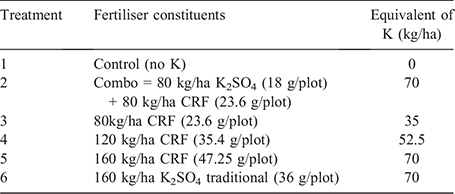
|
After 10 and 20 weeks of growth, 10 L. purpureus plants from a single row in each of the 30 plots were cut off at ~1 cm above ground level and placed into paper bags. Samples were dried at 80°C until a constant mass was attained and then weighed. To quantify concentration of K and Cd in plant material, ~10 youngest, fully expanded leaves were harvested at 10 and 20 weeks from each plot, placed into paper bags, dried at 80°C, ground to a fine powder, ~6 g placed into sterile vials and sent to the MAFRL Laboratory (Murdoch University, Western Australia) for analysis.
Statistical analysis
Simple linear models were fitted for each site separately using the 1m function in R (R Core Team 2017). Response variables for the model were (Cd in leaves, K in leaves and biomass) and treatment (Table 1 for Trial 1 and Table 2 for Trial 2) was the predictor variable with replication (block) as a random variable. The anova function was used to call an ANOVA table for each model. The sites were significantly different from one another and were thus analysed separately. The repeated samples at each date were analysed separately, rather than combining into a complex repeated-measures design, as the results at the end of the trial were considered to be of most importance, with little weight given to the intermediate results. Where the response variable did not meet assumptions of normality (Shapiro–Wilk test) it was log-transformed. Pairwise comparisons between treatments were performed with the post hoc Tukey HSD. Several outliers were removed in the Cd analysis, one from the 160 kg/ha treatment, one from the K2SO4 3-month CRF and two from the K2SO4 9-month CRF due to the values being multiple times the size of the others in the same treatment (assumed to be a laboratory error).
Results
Trial 1: CRF trial
Biomass
After 7 weeks of growth, treatments at Airport 2 significantly differed from one another in terms of biomass (F = 5.631, d.f. = 8,15, P = 0.002), with the immediately available K2SO4 160 kg/ha treatment producing significantly higher biomass than the control (P = 0.0012), KCl 2-month (P = 0.0073) and K2SO4 3-month (P = 0.0018) (Fig. 1). At Airport 5, there were treatment differences (F = 9.94, d.f. = 8,15, P < 0.01), with all treatments producing significantly higher biomass than the control (P < 0.05). At Jindalee, there were no significant differences among treatments (F = 1.894, d.f. = 8,15, P = 0.1363). However, there was a trend towards the immediately available K2SO4 160 kg/ha treatment producing larger biomass than the control (P = 0.0627).
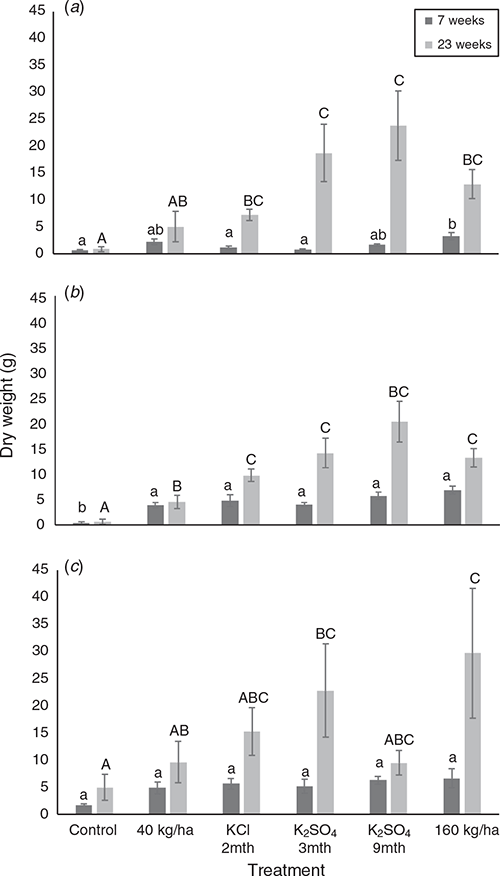
|
After 23 weeks, at Airport 2, treatments significantly differed in biomass (F = 7.145, d.f. = 8,15, P < 0.01). The K2SO4 3-month and 9-month CRFs produced significantly larger biomass than the control (P = 0.0083, P = 0.0004, respectively). Importantly, the K2SO4 9-month produced a higher biomass than the immediately available K2SO4 40 kg/ha (P = 0.0027), which the K2SO4 160 kg/ha did not. At Airport 5, there were also significant treatment responses (F = 7.633, d.f. = 8,15, P < 0.001) with the immediately available K2SO4 160 kg/ha, K2SO4 3-month, K2SO4 9-month and KCl 2-month producing significantly higher biomass than the control (P = 0.0003, P = 0.006, P = 0.0387, P = 0.0022, respectively). Furthermore, the immediately available K2SO4 160 kg/ha, K2SO4 3-month and KCl 2-month produced significantly higher biomass than the immediately available K2SO4 40 kg/ha (P = 0.0015, P = 0.0279, P = 0.010, respectively). At Jindalee, there were also significant treatment differences (F = 7.145, d.f. = 8,15, P < 0.001) with the immediately available K2SO4 160 kg/ha and K2SO4 3-month producing significantly larger biomass than control plants (P = 0.0039 and P = 0.0485, respectively), and the immediately available K2SO4 160 kg/ha producing larger biomass than immediately available K2SO4 40 kg/ha (P = 0.047).
Cd concentrations
The Cd, and other heavy metal, concentrations in L. purpureus declined with increasing biomass (As, r = –0.16; Ni, r = –0.19; Cr, r = –0.16; Pb, r = –0.26), particularly for Cd (r = –0.3) (Fig. 2).
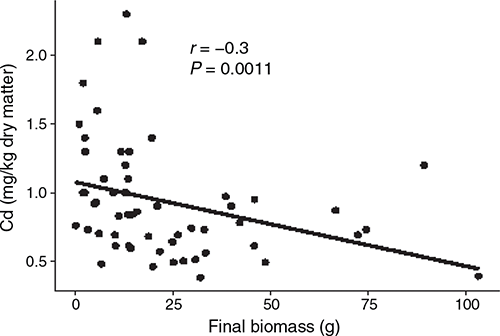
|
After 7 weeks of growth, treatments significantly differed in terms of Cd concentrations at Airport 2 (F = 5.462, d.f. = 8,15, P = 0.002372), with plants in all fertiliser treatments having a significantly lower concentration of Cd than control plants (Fig. 3). For Airport 5, treatment responses were significant (F = 4.192, d.f. = 8,15, P = 0.008187), again, with all treatments having a significantly lower Cd concentration than controls. At Jindalee there were no significant treatment responses (F = 1.315, d.f. = 8,15, P = 0.308).
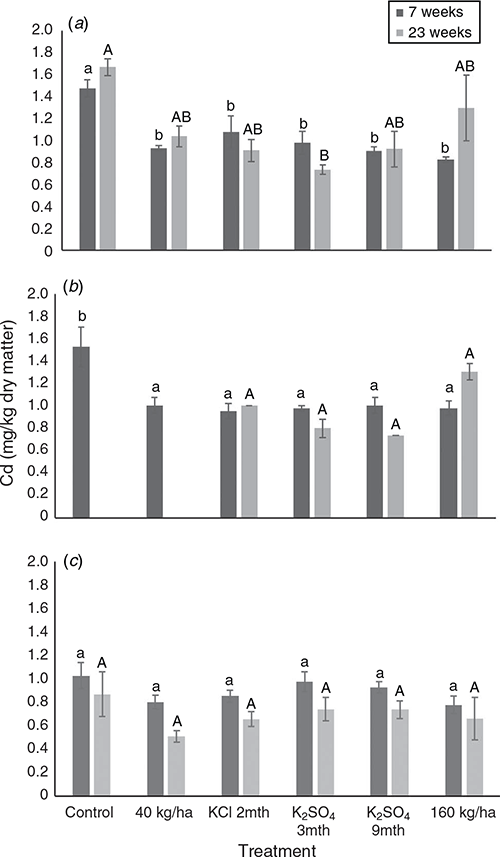
|
After 23 weeks of growth, Airport 2 showed a significant treatment difference (F = 3.5182, d.f. = 8,15, P = 0.03132) with K2SO4 3-month having a significantly lower Cd concentration than the control (P = 0.0325), and the other CRFs having a trend in that direction (Fig. 3). There was no difference between the Cd concentrations in plants from the control and the immediately available K2SO4 160 kg/ha treatment. At Airport 5, analysis could not be undertaken due to missing data. At Jindalee there were no significant differences (F = 0.7767, d.f.= 8,15, P = 0.6293).
K concentrations in plant material
After 7 weeks of growth, at Airport 2, there was a significant treatment effect (F = 16.71, d.f. = 8,15, P < 0.001), with plants from all treatments (except immediately available K2SO4 40 kg/ha) having higher K concentrations than for the control treatment (KCl 2-month, P < 0.001; K2SO4 3-month, P < 0.001; K2SO4 9-month, P < 0.001; immediately available K2SO4 160 kg/ha, P < 0.01) (Fig. 4). Plants treated with KCl 2-month also had higher K concentrations than immediately available K2SO4 40 kg/ha (P < 0.001). At Airport 5, there was also a significant treatment effect (F = 19.37, d.f. = 8,15, P < 0.001), with plants treated with immediately available K2SO4 160 kg/ha and KCl 2-month having higher K concentrations than control plants (both P < 0.001). At Jindalee, was also a significant treatment effect (F = 6.644, d.f. = 8,15, P < 0.001), with again, plants treated with the immediately available K2SO4 160 kg/ha and KCl 2-month having higher K concentrations than control plants (P = 0.004 and P < 0.001, respectively).
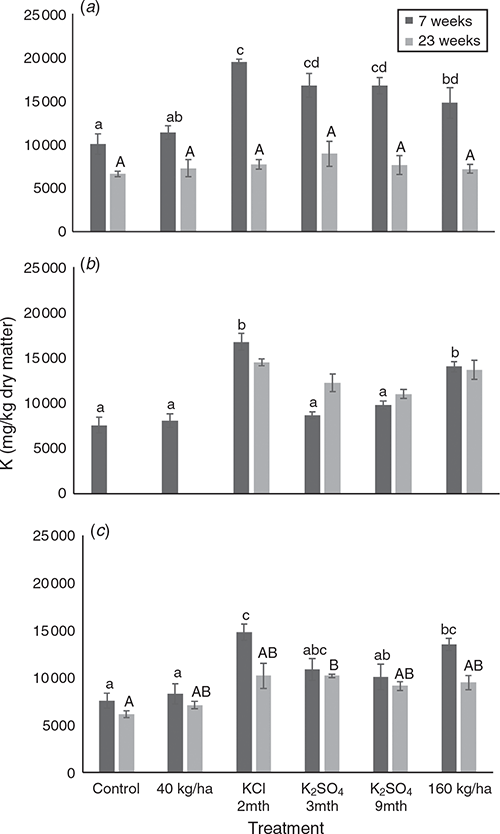
|
After 23 weeks, at Airport 2, there were no significant treatment responses (F = 0.938, d.f. = 8,15, P = 0.5234) (Fig. 4). Airport 5 data could not be analysed for the final harvest, due to missing data. Specifically, there were not enough plants remaining to undertake analysis. For Jindalee, there were significant treatment responses (F = 4.0148, d.f. = 8,15, P = 0.01638); K2SO4 2-month had higher levels than control plants (P = 0.0135).
K in soil
After 30 weeks, the amount of K remaining in the soil was tested in each treatment plot at the Airport 5 and Jindalee sites. The Airport 2 site was no longer available for testing. At Airport 5, there were no significant treatment responses (F = 2.199, d.f. = 8,15, P = 0.09438). At Jindalee, there were also no significant treatment responses (F = 0.7976, d.f. = 8,15, P = 0.5682). However, there was a slight trend suggesting that K from the K2SO4 3-month and 9-month CRF treatments remained in the soil for longer than the other fertilisers (Fig. 5).

|
Trial 2: Rates trial
Biomass
After 10 weeks of growth, there was a significant treatment response at Airport 2 (F = 4.6502, d.f. = 9,20, P = 0.005605) with the plants treated with the immediately available K2SO4 160 kg/ha and combination treatments having higher biomass than control plants (P = 0.0068 and P = 0.0095, respectively) (Fig. 6). At Airport 5, there was also a treatment response (F = 3.7423, d.f. = 9,20, P = 0.01488), with plants treated with immediately available K2SO4 160 kg/ha having higher biomass than control plants (P = 0.0107).
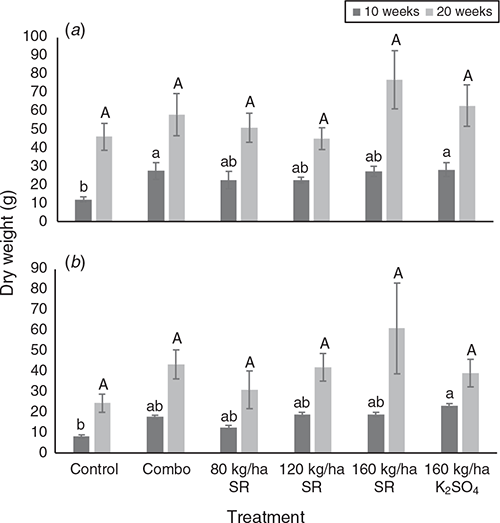
|
After 20 weeks, biomass at Airport 2, no treatments significantly differed from one another (F = 1.2672, d.f. = 9,20, P = 0.3164). At Airport 5, a similar pattern was seen, with no treatments significantly differing from one another (F = 1.3954, d.f. = 9,20, P = 0.2683).
Cd concentrations
After 10 weeks of growth, Cd leaf concentrations at Airport 2 had no significant treatment responses (F = 2.4573, d.f. = 9,20, P = 0.06849) (Fig. 7). At Airport 5, however, there were significant treatment responses (F = 10.4852, d.f. = 9,20, P < 0.001) with the combination treatment; 80, 120 and 160 kg/ha CRF treatments; and the immediately available K2SO4 160 kg/ha treated plants being significantly lower in Cd leaf concentrations than control plants (P = 0.0001, P = 0.007, P = 0.0088, P = 0.0001 and P = 0.0011, respectively). After 20 weeks of growth the Cd concentrations did not significantly differ across the different treatments at Airport 2 (F = 0.9945, d.f. = 9,20, P = 0.44605) or Airport 5 (F = 1.551, d.f. = 9,20, P = 0.1975).
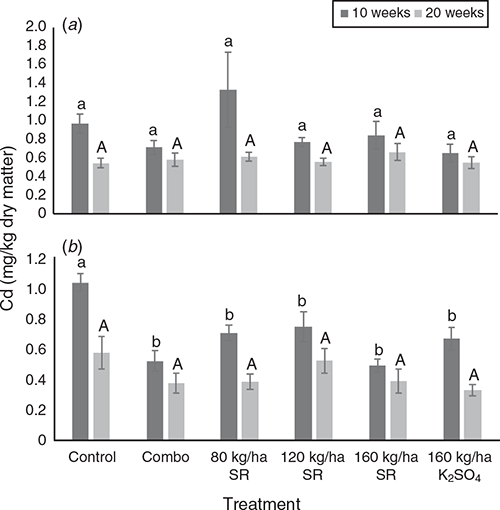
|
K concentrations in plant material
After 10 weeks of growth at Airport 2, there were no significant treatment responses in plant K concentrations (F = 0.9182, d.f. = 9,20, P = 0.4894) (Fig. 8). At Airport 5, there were also no treatment effects (F = 0.4726, d.f. = 9,20, P = 0.7922). After 20 weeks, there were no differences in K concentrations in plants at Airport 2 (F = 0.2473, d.f. = 9,20, P = 0.93628) or Airport 5 (F = 1.9181, d.f. = 9,20, P = 0.1362).
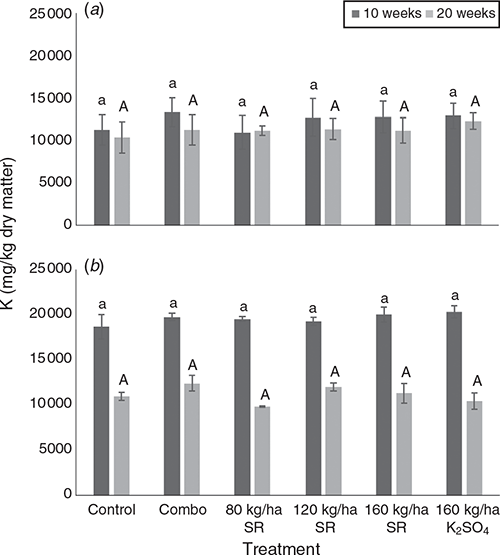
|
Discussion
Our study has shown that although the immediately available K2SO4 fertiliser initially increased L. purpureus biomass, over the longer term the CRFs for K, particularly the K2SO4 3-month CRF treatment, produced similar results to the immediately available K2SO4 fertiliser in terms of increasing plant biomass above control values. This pattern was similar across our three study sites after 23 weeks in Trial 1. Also, Cd concentrations in L. purpureus were significantly lower in plants with higher biomass, which occurred with increasing K addition that included the K2SO4 3-month CRF. Given the results in increased biomass and reduced Cd concentrations that the CRFs showed in this study, which were similar to the immediately available K2SO4 fertiliser, even though CRFs are more expensive, further research on CRFs is warranted. Addition of fertilisers that are highly targeted to specific crops and the prevailing ecological and meteorological conditions may optimise nutrient inputs, maximise yields, reduce waste, minimise runoff and thus form part of the agricultural approach to increasing food security for post-phosphate mining substrates on Christmas Island, but could also be of interest to other phosphate mined sites such as in Florida, and on the island of Nauru (Brown 2005; Ruthrof et al. 2018b).
Although CRFs are more expensive relative to immediately available fertilisers, they do release nutrients sparingly and can be matched with crop uptake requirements, thus reducing waste and leaching (Shaviv 2001; Azeem et al. 2014). In Trial 1, while the immediately available K2SO4 fertiliser initially increased L. purpureus biomass more than the other treatments, over the longer term, the CRFs, especially the K2SO4 3-month and 9-month treatments, compared well with the immediately available K2SO4 fertiliser in terms of increasing plant biomass above control plots. Furthermore, although there was variability among sites, our study illustrated that L. purpureus leaf K concentrations were not significantly different between some CRF treatments and immediately available K2SO4 treated plants. This suggests that the CRFs developed for this trial released K at a rate adequate for plant growth. Indeed, the biomass results of the CRF rates trial (Trial 2), using a K2SO4 9-month CRF, suggest that the rate of release from the CRF was not affected by the amount applied. Given these results, it seems the CRFs formulated for the field trials provided adequate K in this new substrate under the tropical, higher than average rainfall conditions that were experienced during the trial. However, further research is required to determine whether there are further benefits of CRFs to counter their expense (e.g. seed yields, other nutrient levels in plants and seeds, and rate of leaching).
Christmas Island received 5120 mm rainfall in 2016, and 2913 mm in 2017, above its average rainfall of 2183 mm. The controlled release of K from the CRFs was hinted at in the soil K level results at the end of the field trial; although the soil K levels across the treatments were statistically similar, results were highly variable. This suggests that the CRFs may be retained in the soil for a longer period of time, but in a highly patchy fashion, than the immediately available K fertiliser. The CRFs may reduce leaching and waste (Shaviv 2001; Azeem et al. 2014); however, this requires further investigation. Regardless, the K concentration levels within the plants, and the substrate, suggests that these types of CRFs may be important for substrates experiencing high rainfall and potential nutrient leaching.
While not a result of mining, post-phosphate mining soils have naturally elevated levels of heavy metals such as Cd (Ruthrof et al. 2018a, 2018b). Thus, finding methods of reducing heavy metal concentrations is a critical aspect of post-mining agriculture. Our study demonstrated that Cd (and other heavy metal) concentrations were significantly lower in larger L. purpureus plants that had been fertilised with adequate K levels. This could be due to larger plants diluting all non-limiting elements, or larger, healthier plants have a higher water use efficiency. It is thought that K may be involved in the suppression of uptake of other cations (Clarkson and Hanson 1980), may assist with anti-oxidant defence against heavy metal stress (Umar et al. 2013; Song et al. 2015) and may stabilise Cd in the soil and make it less available to plant uptake (Sisr et al. 2007); thus, these processes may also be involved in the reducing Cd in the plants in this study, in addition to a dilution effect.
The pattern found in this trial confirms findings by Ruthrof et al. (2018a), but importantly, which is a novel finding, these results illustrate that some CRFs may also reduce Cd concentrations. This may be significant given the overall cost/benefit of CRFs in this situation; that is, perhaps when one takes into account the potential for reductions in waste, runoff, transportation costs of fertilisers and heavy metal concentrations in crops, then the CRFs may begin to compete, in terms of cost, with readily accessible fertilisers. This is an area requiring further work, given that, in particular, the 3-month CRF fertiliser significantly reduced Cd concentrations in plants at only one of the field sites. Perhaps initially, the immediately available K2SO4 provided enough K to maintain the Cd concentrations at low levels within the plant. At the final harvest, however, this was not the case. Possibly, the continuous delivery of K to plants treated with the CRF sustained the ability of healthy plants to exclude Cd throughout the trial. Clearly, however, this needs further investigation.
The implications for reducing Cd concentrations in crops using added K is multifaceted. First, agricultural crops being grown in post-mining substrates for on-island consumption, or for export, would be safer due to lower levels of a range of heavy metals (Howieson et al. 2017). Second, crops grown for the production of protein-rich animal feed (e.g. pellets for poultry or aquaculture) for the island would also be safer in terms of reduced heavy metal concentrations in feed for animals that are then consumed by humans. Third, the rock phosphate, which is currently exported from the island as a fertiliser, could potentially be developed into higher-value fertiliser products, perhaps containing appropriate and specific nutrients for a range of customers through the addition of CRFs, K or other nutrients. Such product development could diversify and open prospective markets. These are all options that should be investigated and, given the time-sensitive nature, since employment and income from phosphate mining activities may contract by 2030, and there is a need to reduce the economic dependence on imported food products (Howieson et al. 2017), a range of economically, socially and environmentally viable and appropriate options for the island is needed as soon as possible.
Conclusions
Although post-phosphate mining substrates are low in K, and limit growth of legumes such as L. purpureus, high biomass can be attained with appropriate fertiliser application, including CRFs. The K2SO4 3-month CRF compared well with the immediately available K fertiliser at 160 kg/ha K2SO4 in terms of increasing plant biomass significantly above plants in the control plots. Importantly, the concentrations of Cd in L. purpureus decreased with increasing plant biomass, including with the addition of the CRFs, and thus these patterns warrant further examination. Reducing heavy metal concentrations, such as Cd, in crops is particularly important when transitioning from mining to agriculture. Although there were trends, the CRFs did not significantly increase plant K concentrations above the immediately available K or increase K retention in the soil. Optimising nutrient input for agriculture is critical in providing ongoing social, economic and environmental benefits.
Conflicts of interest
The authors declare no conflict of interest.
Declaration of funding
This project received funding through the Australian Research Council (ARC), LP140100690.
Acknowledgments
The authors would like to thank Phosphate Resources Limited, particularly Stephanie Lai, Joy Wickenden, Phoung Le Quang, Choy Lan Seet and Wendy Wong; Parks Australia, particularly Dr Alasdair Grigg; volunteers Lyn O’Brien, Margaret Rogers, Dr Leonie Valentine, Dr Moira Desport and Dr William Ditcham; the Christmas Island Community; the Australian Government Department of Infrastructure and Regional Development; the Australian Research Council (LP140100690); Lorri Skinner and Val Ballard.
References
Azeem B, KuShaari K, Man ZB, Basit A, Thanh TH (2014) Review on materials & methods to produce controlled release coated urea fertilizer. Journal of Controlled Release 181, 11–21.| Review on materials & methods to produce controlled release coated urea fertilizer.Crossref | GoogleScholarGoogle Scholar | 24593892PubMed |
Bakhsh A, Khattak JK, Bhatti AU (1986) Comparative effect of KCl and potassium sulphate on the yield and protein content of wheat in 3 different rotations. Plant and Soil 96, 273–277.
| Comparative effect of KCl and potassium sulphate on the yield and protein content of wheat in 3 different rotations.Crossref | GoogleScholarGoogle Scholar |
Baligar VC, Bennett OL (1986) NPK-fertilizer efficiency—a situation analysis for the tropics. Fertilizer Research 10, 147–164.
| NPK-fertilizer efficiency—a situation analysis for the tropics.Crossref | GoogleScholarGoogle Scholar |
Beringer H, Koch K, Lindhauer MG (1990) Source-sink relationships in potato (Solanum-tuberosum) as influenced by potassium chloride or potassium sulfate nutrition. Plant and Soil 124, 287–290.
| Source-sink relationships in potato (Solanum-tuberosum) as influenced by potassium chloride or potassium sulfate nutrition.Crossref | GoogleScholarGoogle Scholar |
BOM (2018) Climate statistics for Australian locations. Christmas Island Aero. Available at http://www.bom.gov.au/climate/averages/tables/cw_200790.shtml [verified 24 May 2018].
Brown MT (2005) Landscape restoration following phosphate mining: 30 years of co-evolution of science, industry and regulation. Ecological Engineering 24, 309–329.
| Landscape restoration following phosphate mining: 30 years of co-evolution of science, industry and regulation.Crossref | GoogleScholarGoogle Scholar |
Cakmak I (2005) The role of potassium in alleviating detrimental effects of abiotic stresses in plants. Journal of Plant Nutrition and Soil Science 168, 521–530.
| The role of potassium in alleviating detrimental effects of abiotic stresses in plants.Crossref | GoogleScholarGoogle Scholar |
CIP (2015) Christmas Island Phosphates Mine Closure Plan. Christmas Island Phosphate Mine (MCl 70/1A and MCl 70/10) March 2015. Range to Reef Environmental.
Clarkson DT, Hanson JB (1980) The mineral nutrition of higher plants. Annual Review of Plant Physiology and Plant Molecular Biology 31, 239–298.
| The mineral nutrition of higher plants.Crossref | GoogleScholarGoogle Scholar |
Coskun D, Britto DT, Kronzucker HJ (2017) The nitrogen-potassium intersection: membranes, metabolism, and mechanism. Plant, Cell & Environment 40, 2029–2041.
| The nitrogen-potassium intersection: membranes, metabolism, and mechanism.Crossref | GoogleScholarGoogle Scholar |
Das P, Samantaray S, Rout GR (1997) Studies on cadmium toxicity in plants: A review. Environmental Pollution 98, 29–36.
| Studies on cadmium toxicity in plants: A review.Crossref | GoogleScholarGoogle Scholar | 15093342PubMed |
De Meyer SE, Ruthrof KX, Edwards T, Hopkins AJM, Hardy G, O’Hara G, Howieson J (2018) Diversity of endemic rhizobia on Christmas Island: Implications for agriculture following phosphate mining. Systematic and Applied Microbiology 41, 641–649.
| Diversity of endemic rhizobia on Christmas Island: Implications for agriculture following phosphate mining.Crossref | GoogleScholarGoogle Scholar | 30145046PubMed |
Godfray HCJ, Beddington JR, Crute IR, Haddad L, Lawrence D, Muir JF, Pretty J, Robinson S, Thomas SM, Toulmin C (2010) Food security: the challenge of feeding 9 billion people. Science 327, 812–818.
| Food security: the challenge of feeding 9 billion people.Crossref | GoogleScholarGoogle Scholar |
Gray HS (1981) ‘Christmas Island - Naturally. The natural history of an isolated oceanic island. The Australian Territory of Christmas Island, Indian Ocean.’ (Howard Gray: Geraldton, Western Australia)
Howieson J, Calmy H, Ballard N, Skinner P, WO’Hara G, Skinner L, Ruthrof KX, Swift R, Ballard V, St Hardy GE, McHenry MP (2017) Bread from stones: Post-mining land use change from phosphate mining to farmland. The Extractive Industries and Society 4, 290–299.
| Bread from stones: Post-mining land use change from phosphate mining to farmland.Crossref | GoogleScholarGoogle Scholar |
Kafkafi U, Xu G, Imas P, Magen H, Tarchitzky J (2001) ‘Potassium and chloride in crops and soils: the role of potassium chloride fertilizer in crop nutrition.’ (International Potash Institute: Basel, Switzerland)
Liu C, Tu B, Wang X, Jin J, Li Y, Zhang Q, Ma B (2019) Potassium translocation combined with specific root uptake is responsible for the high potassium efficiency in vegetable soybean. Crop and Pasture Science 70, 516–525.
| Potassium translocation combined with specific root uptake is responsible for the high potassium efficiency in vegetable soybean.Crossref | GoogleScholarGoogle Scholar |
Marschner H (1995) Functions of mineral nutrients: macronutrients. In ‘Mineral nutrition of higher plants’. 2nd edn. (Ed. H Marschner) pp. 229–312. (Academic Press: London)
McHenry M, Persley G (2015) ‘Bread and stones: co-investing in mining and agriculture in Africa.’ (Crawford Fund, Murdoch University, Perth, Western Australia, and Canberra, Australian Capital Territory, Australia)
Noraho N, Gaur JP (1995) Effect of cations, including heavy-metals, on cadmium uptake by Lemna polyrhiza L. Biometals 8, 95–98.
| Effect of cations, including heavy-metals, on cadmium uptake by Lemna polyrhiza L.Crossref | GoogleScholarGoogle Scholar |
Pervez H, Ashraf M, Makhdum MI (2005) Influence of potassium rates and sources on seed cotton yield and yield components of some elite cotton cultivars. Journal of Plant Nutrition 27, 1295–1317.
| Influence of potassium rates and sources on seed cotton yield and yield components of some elite cotton cultivars.Crossref | GoogleScholarGoogle Scholar |
R Core Team (2017) R: A language and environment for statistical computing. Vienna, Austria.
Rowland SM, Prescott CE, Grayston SJ, Quideau SA, Bradfield GE (2009) Recreating a functioning forest soil in reclaimed oil sands in Northern Alberta: an approach for measuring success in ecological restoration. Journal of Environmental Quality 38, 1580–1590.
| Recreating a functioning forest soil in reclaimed oil sands in Northern Alberta: an approach for measuring success in ecological restoration.Crossref | GoogleScholarGoogle Scholar | 19549934PubMed |
Ruthrof KX (1997) Improving the success of limestone quarry revegetation. Cave and Karst Science 24, 111–120.
Ruthrof KX, Fontaine JB, Hopkins AJM, McHenry MP, O’Hara G, McComb J, Hardy G, Howieson J (2018a) Potassium amendment increases biomass and reduces heavy metal concentrations in Lablab purpureus after phosphate mining. Land Degradation & Development 29, 398–407.
| Potassium amendment increases biomass and reduces heavy metal concentrations in Lablab purpureus after phosphate mining.Crossref | GoogleScholarGoogle Scholar |
Ruthrof KX, Steel E, Misra S, McComb J, O’Hara G, Hardy GES, Howieson J (2018b) Transitioning from phosphate mining to agriculture: Responses to urea and slow release fertilizers for Sorghum bicolor. The Science of the Total Environment 625, 1–7.
| Transitioning from phosphate mining to agriculture: Responses to urea and slow release fertilizers for Sorghum bicolor.Crossref | GoogleScholarGoogle Scholar | 29278826PubMed |
SGS (2010) Horticulture feasibility study for the Indian Ocean 10 territories. SGS Economics and Planning Pty. Ltd. and Trust Nature Pty. Ltd., Christmas Island Phosphates, West Perth.
Shamsi IH, Jilani G, Zhang GP, Wei K (2008) Cadmium stress tolerance through potassium nutrition in soybean. Asian Journal of Chemistry 2, 1099–1108.
Shamsi IH, Jiang LX, Wei K, Jilani G, Hua SJ, Zhang GP (2010) Alleviation of cadmium toxicity in soybean by potassium supplementation. Journal of Plant Nutrition 33, 1926–1938.
| Alleviation of cadmium toxicity in soybean by potassium supplementation.Crossref | GoogleScholarGoogle Scholar |
Shaviv A (2001) Advances in controlled-release fertilizers. Advances in Agronomy 71, 1–49.
| Advances in controlled-release fertilizers.Crossref | GoogleScholarGoogle Scholar |
Singh A, Singh JS (2001) Comparative growth behaviour and leaf nutrient status of native trees planted on mine spoil with and without nutrient amendment. Annals of Botany 87, 777–787.
| Comparative growth behaviour and leaf nutrient status of native trees planted on mine spoil with and without nutrient amendment.Crossref | GoogleScholarGoogle Scholar |
Singh B, Singh Y, Imas P, Jian-Chang X (2003) Potassium nutrition of the rice-wheat cropping system. Advances in Agronomy 81, 203–259.
| Potassium nutrition of the rice-wheat cropping system.Crossref | GoogleScholarGoogle Scholar |
Sisr L, Mihaljevic M, Ettler V, Strnad L, Sebek O (2007) Effect of application of phosphate and organic manure-based fertilizers on arsenic transformation in soil columns. Environmental Monitoring and Assessment 135, 465–473.
| Effect of application of phosphate and organic manure-based fertilizers on arsenic transformation in soil columns.Crossref | GoogleScholarGoogle Scholar | 17370134PubMed |
Song ZZ, Duan CL, Guo SL, Yang Y, Feng YF, Ma RJ, Yu ML (2015) Potassium contributes to zinc stress tolerance in peach (Prunus persica) seedlings by enhancing photosynthesis and the antioxidant defense system. Genetics and Molecular Research 14, 8338–8351.
| Potassium contributes to zinc stress tolerance in peach (Prunus persica) seedlings by enhancing photosynthesis and the antioxidant defense system.Crossref | GoogleScholarGoogle Scholar | 26345760PubMed |
Tischew S, Kirmer A (2007) Implementation of basic studies in the ecological restoration of surface-mined land. Restoration Ecology 15, 321–325.
| Implementation of basic studies in the ecological restoration of surface-mined land.Crossref | GoogleScholarGoogle Scholar |
Umar S, Gauba N, Anjum NA, Siddiqi TO (2013) Arsenic toxicity in garden cress (Lepidium sativum Linn.): significance of potassium nutrition. Environmental Science and Pollution Research International 20, 6039–6049.
| Arsenic toxicity in garden cress (Lepidium sativum Linn.): significance of potassium nutrition.Crossref | GoogleScholarGoogle Scholar | 23529401PubMed |
Yang XY, Geng JBA, Li CL, Zhang M, Tian XF (2016) Cumulative release characteristics of controlled-release nitrogen and potassium fertilizers and their effects on soil fertility, and cotton growth. Scientific Reports 6, 39030
| Cumulative release characteristics of controlled-release nitrogen and potassium fertilizers and their effects on soil fertility, and cotton growth.Crossref | GoogleScholarGoogle Scholar |
Younis M (2007) Responses of Lablab purpureus-rhizobium symbiosis to heavy metals in pot and field experiments. World Journal of Agricultural Sciences 3, 111–122.
Zhang F, Niu JF, Zhang WF, Chen XP, Li CJ, Yuan LX, Xie JC (2010) Potassium nutrition of crops under varied regimes of nitrogen supply. Plant and Soil 335, 21–34.
| Potassium nutrition of crops under varied regimes of nitrogen supply.Crossref | GoogleScholarGoogle Scholar |
Zhao ZQ, Zhu YG, Li HY, Smith SE, Smith FA (2004) Effects of forms and rates of potassium fertilizers on cadmium uptake by two cultivars of spring wheat (Triticum aestivum, L.). Environment International 29, 973–978.
| Effects of forms and rates of potassium fertilizers on cadmium uptake by two cultivars of spring wheat (Triticum aestivum, L.).Crossref | GoogleScholarGoogle Scholar | 14592574PubMed |


